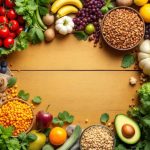Maintaining a healthy diet is crucial for women at all stages of life. A balanced and nutritious diet helps to ensure proper body function, supports hormonal balance, and can prevent various health issues.
Women have unique nutritional needs that evolve with different life stages, from adolescence through pregnancy to menopause and beyond. For example, iron needs to increase during menstruation, while calcium and vitamin D become more critical with age to support bone health.
Proper nutrition is not just about physical health; it also impacts mental well-being by providing the necessary nutrients that promote better mood and cognitive function.
By understanding and addressing these specific dietary requirements, women can achieve optimal health and enhance their overall quality of life.
1: Essential Nutrients
1.1 Protein
Protein is a vital nutrient that plays a crucial role in muscle maintenance and overall health. It serves as the building block for muscles, skin, enzymes, and hormones. For women, consuming adequate protein is especially important for sustaining tissue repair, immune function, and overall energy levels.
The recommended daily intake of protein varies depending on age, activity level, and overall health, but a common guideline suggests that women should aim for about 46 grams of protein per day. However, active women or those looking to build muscle mass may require more.
Incorporating a variety of protein sources into your diet ensures you get a range of essential amino acids. Some of the best sources of protein include lean meats like chicken and turkey, beans, legumes, nuts, seeds, and dairy products. Plant-based sources such as tofu, tempeh, and lentils are excellent for those following vegetarian or vegan diets. By balancing these diverse protein sources, women can support their muscle health and overall well-being effectively.
1.2 Calcium and Vitamin D
Calcium and Vitamin D are essential nutrients that play critical roles in maintaining bone health and preventing conditions such as osteoporosis, which is particularly important for women as they age. Calcium is a mineral that is necessary for the development and maintenance of strong bones and teeth, as well as for the proper function of the heart, muscles, and nerves. Vitamin D, on the other hand, helps the body absorb calcium efficiently and supports muscle function and the immune system.
The daily requirements for calcium vary depending on age. Women aged 19-50 are generally recommended to consume 1,000 milligrams per day, while those over 50 should aim for 1,200 milligrams daily. For Vitamin D, the recommended intake is usually around 600 international units (IU) per day for most adults, increasing to 800 IU for those over the age of 70.
Obtaining these nutrients from a variety of food sources can help meet these daily requirements. Rich sources of calcium include dairy products like milk, yogurt, and cheese. For those who are lactose intolerant or prefer non-dairy options, leafy green vegetables such as kale and broccoli, fortified foods like certain cereals and plant-based milk, and canned fish with bones like sardines are excellent alternatives.
Vitamin D can be found in fatty fish like salmon and mackerel, fortified dairy and plant milk, and egg yolks. Additionally, sunlight exposure helps the body synthesize Vitamin D, making outdoor activities an important part of maintaining adequate levels. By focusing on a diet rich in these sources, women can support their bone health effectively throughout their lives.
1.3 Iron
Iron is an essential mineral that plays a pivotal role in blood health by aiding in the production of hemoglobin, the protein in red blood cells responsible for transporting oxygen throughout the body. Adequate iron levels are crucial for preventing anemia, a condition characterized by fatigue, weakness, and dizziness due to insufficient red blood cells.
For women, particularly those who are menstruating, iron needs are higher due to the regular loss of blood. The recommended daily intake for menstruating women is approximately 18 milligrams, while non-menstruating women require around 8 milligrams. Pregnancy increases these needs even further, as the body requires extra iron to support the growing fetus and increased blood volume.
Dietary sources of iron can be found in a variety of foods, ensuring that women can meet their iron needs through a balanced diet. Heme iron, found in animal products, is more easily absorbed by the body and includes sources such as red meat, poultry, and fish. Non-heme iron, found in plant-based foods, is also important and includes lentils, spinach, beans, tofu, and fortified cereals.
Consuming vitamin C-rich foods like citrus fruits, tomatoes, and bell peppers alongside iron-rich foods can enhance iron absorption. By incorporating these dietary sources, women can maintain optimal iron levels and support their overall blood health effectively.
1.4 Omega-3 Fatty Acids
Omega-3 fatty acids are beneficial fats that play a critical role in maintaining heart and brain health. These essential fats are known for their anti-inflammatory properties and their ability to reduce the risk of chronic diseases. For women, incorporating omega-3 fatty acids into their diet can help lower blood pressure, reduce triglycerides, and decrease the likelihood of heart disease. Additionally, omega-3s are vital for brain function, supporting cognitive health, and reducing symptoms of depression and anxiety.
The daily recommended intake of omega-3 fatty acids varies depending on overall health and specific dietary goals, but a general guideline suggests that women should aim for about 250-500 milligrams of combined EPA and DHA per day. Pregnant and breastfeeding women may require higher amounts to support the development of the baby’s brain and nervous system.
To meet these daily requirements, incorporating a variety of omega-3-rich foods into your diet is key. Fatty fish such as salmon, mackerel, sardines, and trout are among the best sources, providing high levels of EPA and DHA. For those who follow a vegetarian or vegan diet, plant-based sources are also available, such as flaxseeds, chia seeds, walnuts, and hemp seeds.
Algal oil supplements can be an excellent alternative for those who do not consume fish. By including these nutrient-dense foods in their meals, women can support both their heart and brain health effectively.
2: Healthy Eating Habits
2.1 Balanced Meals
Maintaining a balanced plate is crucial for ensuring that you receive all the necessary nutrients for optimal health and well-being. A balanced meal typically includes a variety of food groups, each providing essential vitamins, minerals, and other nutrients your body needs to function efficiently.
Importance of a Balanced Plate
A well-balanced meal not only supports overall health but also helps regulate energy levels, maintain a healthy weight, and reduce the risk of chronic diseases. Consuming a wide array of foods ensures that you are getting a diversity of nutrients, which can support bodily functions ranging from metabolic processes to immune defense.
Tips for Including All Food Groups in Meals
To create a balanced plate, aim to include the following food groups:
- Fruits and Vegetables: Fill half of your plate with a colorful variety of fruits and vegetables. These are rich in vitamins, minerals, and fiber.
- Proteins: One-quarter of your plate should include protein sources such as lean meats, beans, legumes, tofu, or nuts.
- Whole Grains: The remaining quarter should consist of whole grains like quinoa, brown rice, or whole-wheat pasta.
- Dairy or Dairy Alternatives: Include a serving of dairy or fortified non-dairy alternatives to provide calcium and vitamin D.
Portion Control Tips
Portion control is a key element of balanced eating, ensuring you consume the right amount of food without overeating. Here are some simple tips:
- Use smaller plates and bowls: This can help control portion sizes and prevent overeating.
- Pay attention to hunger and fullness cues: Eat slowly and listen to your body’s signals to avoid consuming more than needed.
- Read food labels: Understanding serving sizes mentioned on labels can help you gauge appropriate portions.
- Plan your meals: Preparing meals in advance allows you to control portion sizes and make healthier food choices.
By focusing on a balanced plate and mindful eating, you can develop healthy eating habits that support long-term wellness.
2.2 Hydration
Role of Water in the Body’s Functions
Water is essential for virtually every function in the human body. It comprises about 60% of our body weight and is vital for maintaining homeostasis. Water aids in digestion, nutrient absorption, temperature regulation, and the elimination of waste. It also ensures that cells are properly hydrated, which is crucial for maintaining healthy skin, muscles, and joints.
Recommended Daily Water Intake
The amount of water each person needs can vary based on factors such as age, sex, weight, and activity level. However, a general guideline is that women should aim for about 2.7 liters (91 ounces) of water per day from all beverages and foods. This is roughly 8-11 cups of water daily. Staying adequately hydrated is especially important for those who are physically active, pregnant, or breastfeeding, as their requirements may be higher.
Tips for Staying Hydrated
Staying properly hydrated can sometimes be challenging, but here are some practical tips to help:
- Use a Water Bottle: Keep a reusable water bottle with you to remind yourself to drink water throughout the day. Choose a bottle with measurement markings to track your intake.
- Eat Water-Rich Foods: Incorporate fruits and vegetables with high water content into your meals, such as cucumbers, watermelon, strawberries, and lettuce, which contribute to your overall hydration.
- Set Reminders: Use your phone or a hydration app to set regular reminders to take a sip of water.
- Drink Before You Feel Thirsty: Don’t wait until you’re thirsty to drink water; thirst can often be an indicator that you’re already dehydrated.
- Flavor Your Water: If plain water feels boring, try adding a splash of natural flavor with slices of lemon, lime, or cucumber.
- Monitor Your Urine Color: Aim for light yellow urine, which is a good indicator of proper hydration.
By understanding the importance of hydration and incorporating these simple tips, you can ensure that you remain well-hydrated and support your body’s functions efficiently.
2.3 Mindful Eating
Benefits of Being Present While Eating
Practicing mindful eating involves being fully present and engaged during your meals, paying attention to the sensory experiences of eating, and tuning into your body’s hunger and fullness signals. This approach to eating brings numerous benefits:
- Improved Digestion: Being mindful can lead to better chewing and digestion, which enhances nutrient absorption.
- Weight Management: When you eat slowly and attentively, you are more likely to recognize when you are full, which can help prevent overeating.
- Enhanced Enjoyment: Savoring each bite intensifies the pleasure you get from your food, contributing to a more satisfying meal experience.
- Reduced Stress: Taking time to enjoy your meals without distractions can act as a form of meditation, reducing stress levels and improving your overall well-being.
Tips for Practicing Mindful Eating
Implementing mindful eating into your daily routine can be simple with a few practical tips:
- Avoid Distractions: Turn off the television, set aside your phone, and remove any other potential distractions to focus solely on your meal.
- Eat Slowly: Take your time to chew your food thoroughly and savor each bite. This not only aids digestion but also allows you to enjoy the flavors and textures of your food more fully.
- Listen to Your Body: Pay attention to your body’s hunger and fullness cues. Start eating when you feel true hunger and stop when you are comfortably full.
- Engage Your Senses: Notice the colors, smells, textures, and tastes of your food. Engaging your senses can enhance the overall eating experience.
- Take Small Bites: Taking smaller bites and setting your fork down between bites can help you pace your eating and make your meal last longer.
- Express Gratitude: Before eating, take a moment to appreciate the effort that went into preparing your meal. This can enhance your joy and satisfaction from eating.
- Practice Regularly: Mindful eating is a skill that improves with practice. Try to incorporate it into at least one meal per day to start reaping its benefits.
By adopting mindful eating habits, you can transform meals into a more fulfilling and healthful experience, supporting both your physical and mental well-being.
3: Special Considerations
3.1 Diet During Pregnancy
Maintaining a well-balanced diet during pregnancy is crucial for the health of both the mother and the developing baby. Proper nutrition supports optimal fetal growth, reduces the risk of complications, and helps manage common pregnancy symptoms.
Key Nutrients for a Healthy Pregnancy
Ensuring an adequate intake of certain key nutrients is essential during pregnancy:
- Folic Acid: Vital for preventing neural tube defects, it is recommended to take 400-800 micrograms daily. Leafy greens, legumes, and fortified cereals are good sources.
- Iron: Important for preventing anemia, aim for 27 milligrams per day. Incorporate lean meats, spinach, and legumes into your diet.
- Calcium: For developing strong bones and teeth in the baby, aim for 1000 milligrams daily. Dairy products, fortified plant milk, and leafy greens are excellent options.
- Vitamin D: Supports immune function and bone health, 600 IU per day is recommended. Sources include sunlight exposure, fortified milk, and fatty fish.
- Omega-3 Fatty Acids: Crucial for brain and eye development, eat 200-300 milligrams of DHA daily. Fatty fish like salmon, as well as flaxseeds and walnuts, are rich in Omega-3s.
- Protein: Supports the growth of fetal tissue, aim for 70-100 grams daily. Good sources are lean meats, eggs, dairy products, and plant-based proteins like beans and tofu.
Tips for Managing Morning Sickness and Cravings
Morning sickness and cravings are common during pregnancy, but they can often be managed with some practical strategies:
- Eat Small, Frequent Meals: This can prevent nausea and keep your energy levels stable. Aim for 5-6 small meals throughout the day.
- Stay Hydrated: Sip on water, clear broths, or ginger tea throughout the day to stay hydrated and reduce nausea.
- Keep Snacks Handy: Having crackers, nuts, or fruit readily available can help manage sudden hunger or nausea.
- Listen to Your Cravings: Satisfy cravings with healthy alternatives when possible. If you crave sweets, opt for fruit; for salty snacks, try nuts or whole-grain crackers.
- Avoid Strong Smells: Certain odors can exacerbate nausea; try eating cold or room-temperature foods to minimize smells.
- Ginger and Lemon: These can help alleviate nausea. Try ginger tea, ginger chews, or lemon water.
Sample Meal Plans
To ensure you get a variety of nutrients, here are some sample meal plans for a day:
Breakfast:
- Scrambled eggs with spinach and whole-grain toast
- Orange juice
Morning Snack:
- Greek yogurt with a handful of berries and a sprinkle of flaxseeds
Lunch:
- Grilled chicken salad with mixed greens, cherry tomatoes, cucumber, and a lemon vinaigrette
- Whole-grain roll
Afternoon Snack:
- Carrot sticks with hummus
Dinner:
- Baked salmon with quinoa and steamed broccoli
- A glass of fortified plant milk
Evening Snack:
- A small bowl of mixed nuts and dried fruit
By focusing on these key nutrients and incorporating these tips and meal ideas, you can support a healthy pregnancy for both you and your baby.
3.2 Menopause and Beyond
As women transition through menopause and into their post-menopausal years, dietary needs can change to address shifts in hormones, bone density, and overall health. A focus on nutrition during this time can help support well-being and manage symptoms like hot flashes, weight gain, and mood swings.
Dietary Needs for Menopausal and Post-Menopausal Women
During and after menopause, certain nutrients become increasingly important to help maintain health and mitigate the risks of osteoporosis and heart disease:
- Calcium: Essential for bone health, aim for 1200 milligrams daily. Sources include dairy products, fortified plant milks, and leafy greens.
- Vitamin D: Aids in calcium absorption and supports immune function. Aim for 600-800 IU per day, obtainable through sunlight exposure, fortified foods, and fatty fish.
- Magnesium: Supports bone health and energy levels. Include nuts, seeds, legumes, and whole grains in your diet.
- Protein: Helps preserve muscle mass, which can decline with age. Aim for 1-1.2 grams of protein per kilogram of body weight, incorporating lean meats, fish, dairy, and plant-based proteins.
- Omega-3 Fatty Acids: Can help manage inflammation and support heart health. Include fatty fish, flaxseeds, and walnuts in your meals.
- Phytoestrogens: Plant compounds that can mimic estrogen and may help ease symptoms. Found in soy products, flaxseeds, and legumes.
Foods to Support Hormonal Balance
In addition to specific nutrients, certain foods can support hormonal balance and alleviate menopausal symptoms:
- Soy Products: Tofu, tempeh, and soy milk contain phytoestrogens that may help balance hormones.
- Flaxseeds: Rich in lignans, a type of phytoestrogen, which can help manage symptoms.
- Whole Grains: Brown rice, oats, and quinoa provide fiber and stabilize blood sugar levels.
- Fruits and Vegetables: High in antioxidants and fiber, they support overall health and well-being.
- Healthy Fats: Avocado, olive oil, and nuts support heart health and brain function.
Foods to Limit or Avoid
Certain foods can exacerbate menopausal symptoms and negatively impact health, so it’s wise to limit or avoid them:
- Processed Sugars: Can cause blood sugar spikes and increase the risk of weight gain and diabetes.
- Alcohol: May worsen hot flashes and disrupt sleep patterns.
- Caffeine: Can trigger hot flashes and contribute to anxiety and insomnia.
- High-Sodium Foods: Increase blood pressure and the risk of osteoporosis.
- Saturated and Trans Fats: Found in fried and processed foods, these can elevate cholesterol levels and promote heart disease.
By tailoring your diet to include supportive nutrients and foods while limiting those that can worsen symptoms, you can navigate menopause and beyond with better health and comfort.
4: Meal Planning and Preparation
4.1 Planning Ahead
Effective meal planning can significantly enhance your nutritional intake, save time, and reduce stress throughout the week. By dedicating a little time to plan your meals, you can ensure a balanced diet that meets your health needs and preferences.
Benefits of Meal Planning:
- Nutritional Balance: Planning meals ahead allows for a varied and nutritious diet. You can ensure you’re including a mix of proteins, carbohydrates, healthy fats, and a colorful array of fruits and vegetables.
- Time-Saving: Having a plan in place means fewer last-minute decisions, reducing the time spent figuring out what to cook each day. Batch cooking and preparing ingredients in advance can also save time during busy weekdays.
- Cost-Efficient: Meal planning helps prevent impulse buys and unnecessary purchases. By sticking to a well-thought-out list, you can make the most of your budget and reduce food waste.
- Stress Reduction: Knowing what you’re going to eat each day can alleviate the daily stress of trying to decide on meals, especially when schedules are hectic.
- Health Goals: It supports specific health goals, whether you’re aiming for weight management, dietary restrictions, or improving overall wellness.
Tips for Creating a Weekly Meal Plan:
- Set Aside Time: Choose a specific day of the week to plan your meals, make your grocery list, and do your shopping.
- Consider Your Schedule: Look at your upcoming week to factor in busy days where quick and easy meals are necessary, as well as days where you might have more time to cook.
- Diversify Your Meals: Incorporate a variety of foods to keep meals exciting and nutritionally balanced. Rotate proteins, grains, and vegetables to avoid monotony.
- Batch Cooking: Prepare large quantities of versatile ingredients like grains, proteins, or roasted vegetables that can be used in multiple meals throughout the week.
- Plan for Leftovers: Intentionally cook extra portions for some meals to have leftovers for lunch or dinner on another day.
- Enjoy Flexibility: While having a plan is great, allow for some flexibility. Life happens, and sometimes plans need to adapt.
Using a Grocery List for Efficient Shopping:
- Master List: Keep a master grocery list of items you frequently use. This can be a great reference to ensure you’re always stocked on essentials.
- Categorize Items: Organize your list by categories such as produce, dairy, grains, and proteins. This can make your shopping trip quicker and more efficient.
- Stick to the Plan: Adhering to your list helps limit impulse buys and ensures you have all the ingredients needed for your planned meals.
- Check Your Pantry: Before heading out, go through your pantry, fridge, and freezer to see what you already have. This prevents buying duplicates and helps in using up existing ingredients.
By incorporating meal planning into your routine, you can enjoy nutritious, delicious meals without the hassle, ensuring a healthful diet and easing your daily schedule.
4.2 Easy and Healthy Recipes
Creating easy and healthy recipes can transform your meal times, making nutritious eating both convenient and enjoyable. Here are some quick meal and snack ideas, along with tips to help you maintain a healthy diet effortlessly.
Breakfast Ideas
- Overnight Oats: A blend of oats, chia seeds, yogurt, and your favorite fruits soaked overnight for a ready-to-eat breakfast.
- Smoothie Bowls: Blend frozen fruits, spinach, and a scoop of protein powder, then top with granola, nuts, and fresh berries.
Lunch Ideas
- Quinoa Salad: Combine cooked quinoa with black beans, corn, bell peppers, and avocado. Toss with a lime-cumin dressing.
- Veggie Wraps: Fill whole-wheat tortillas with hummus, spinach, shredded carrots, cucumber, and a sprinkle of feta cheese.
Dinner Ideas
- Sheet Pan Chicken and Veggies: Toss chicken breasts, broccoli, cherry tomatoes, and sweet potatoes with olive oil and your favorite herbs, then roast until cooked.
- Stir-Fry: Sauté a mix of seasonal vegetables with tofu or chicken, and a simple sauce made of soy sauce, ginger, and garlic. Serve over brown rice or noodles.
Snack Ideas
- Fruit and Nut Bars: Combine dates, almonds, oats, and a touch of honey, then press into a pan and refrigerate until set.
- Veggie Sticks and Hummus: Enjoy sliced carrots, celery, and bell peppers with a side of protein-packed hummus.
Tips for Making Healthy Eating Convenient and Enjoyable
- Prep Ahead: Wash and chop vegetables and fruits as soon as you get home from the store to make them easily accessible.
- Cook in Batches: Make large portions of grains, proteins, or soups to use throughout the week.
- Use Versatile Ingredients: Choose ingredients that can be used in multiple recipes to save time and reduce waste.
- Keep Healthy Snacks Handy: Stock up on nuts, seeds, and dried fruits for quick and wholesome snacks.
By incorporating these easy and healthy recipes into your meal plan, you can enjoy delicious, nutritious food without the hassle, ensuring a balanced diet and more enjoyable meal times.
Conclusion
Incorporating meal planning and easy, healthy recipes into your daily routine can significantly improve your overall well-being. To recap the key points:
- Meal Planning Benefits: Saves time and money, reduces stress, and supports specific health goals.
- Creating a Weekly Meal Plan: Set aside time, consider your schedule, diversify your meals, batch cook, plan for leftovers, and allow flexibility.
- Efficient Grocery Shopping: Use a master list, categorize items, stick to your plan, and check your pantry before shopping.
- Easy and Healthy Recipes: From overnight oats for breakfast to sheet pan chicken and veggies for dinner, having quick meal options makes nutritious eating convenient.
- Tips for Healthy Eating: Prep ahead, cook in batches, use versatile ingredients, and keep healthy snacks handy.
Remember, making changes to your diet and routine doesn’t have to be overwhelming. Start with gradual, sustainable changes that fit your lifestyle. Perhaps begin with planning a few meals a week and slowly build up as you become more comfortable. It’s the small, consistent steps that lead to lasting success.
Finally, always listen to your body and enjoy the journey towards a healthier, happier you. Whether you’re experimenting with new recipes or refining your meal planning skills, every effort you make is a step in the right direction. Happy healthy eating!
Additional Resources
Helpful Websites
- Healthline: Comprehensive resource for information on nutrition, healthy recipes, and wellness tips.
- MyFitnessPal: Offers meal tracking and nutritional information, plus a community for support and advice.
- Minimalist Baker: Provides simple, quick recipes that require minimal ingredients and equipment.
- Eat This, Not That!: Offers insights on healthy food choices, recipes, and diet tips.
Recommended Books
- “The Meal Prep King Plan” by John Clark and Charlotte Garside: A guide to meal prepping with nutritious and delicious recipes.
- “How Not to Die” by Dr. Michael Greger: Explores the role of nutrition in preventing and reversing disease, with practical tips and recipes.
- “The Healthy Meal Prep Cookbook” by Toby Amidor: Focuses on easy, nutritious meal prep plans and recipes for everyday life.
Useful Apps
- MyFitnessPal: Tracks meals, and exercises, and provides nutritional insights.
- Yummly: Offers personalized recipe recommendations and meal planning assistance.
- Lifesum: Nutrition app that helps track food intake, and diets, and offers healthy recipe ideas.
- Paprika Recipe Manager: Allows you to organize your recipes, create meal plans, and generate grocery lists.
Community Groups and Forums
- Reddit – Meal Prep Sunday: A supportive community sharing meal prep tips, recipes, and experiences.
- SparkPeople: Online community with forums focusing on nutrition, healthy recipes, and lifestyle changes.
By leveraging these additional resources, you can find further support, inspiration, and information on your journey to healthier eating and meal planning. Don’t hesitate to explore these tools to enhance your experience and connect with others who share your goals.
Frequently Asked Questions (FAQs)
1. What if I don’t have time to meal plan every week?
Even small steps can make a big difference. Start with planning just a few meals or snacks, and gradually increase as you get comfortable. You can also use weekends or less busy days to prepare ingredients or cook meals in advance.
2. How do I make sure my meal plan stays interesting?
Variety is key. Incorporate different cuisines, try new recipes, and use seasonal ingredients to keep things exciting. Rotating your meal options also ensures you get a wide range of nutrients.
3. Can I meal plan on a budget?
Absolutely! Focus on buying seasonal produce, bulk items like grains and legumes, and making use of sales or discounts. Planning meals around what’s on sale can also be a great way to save money.
4. What if I don’t have special kitchen equipment?
Simple tools will suffice for most recipes. Basic items like a good knife, cutting board, pots, and pans can handle most cooking tasks. Look for minimal equipment recipes, and gradually build your kitchen arsenal as needed.
5. How do I store prepped meals safely?
Use airtight containers to store prepped meals and label them with dates. Keep them refrigerated if they’re for the next few days, or freeze them for longer storage. Ensure leftovers are reheated thoroughly before eating.
6. What are some quick and healthy snack ideas?
Keep it simple with options like fresh fruit, nuts, yogurt, veggie sticks with hummus, or whole-grain crackers with cheese. Having these readily available can help you maintain healthy eating habits.
7. Is it okay to repeat meals?
Yes, it’s perfectly fine to enjoy the same meal multiple times a week. Repeating meals can save time and reduce decision fatigue. Just ensure you’re still getting a balanced diet overall.
8. How do I get my family involved in meal planning?
Involve family members by letting them choose a meal for the week, helping with grocery shopping, or participating in cooking. Making it a collaborative effort can make meal planning more enjoyable and inclusive.
9. What if I don’t follow my meal plan exactly?
Flexibility is essential. If something comes up and you can’t stick to the plan, don’t worry. It’s more important to adapt and make healthy choices whenever possible. Use your meal plan as a guide rather than a strict set of rules.
10. How can I ensure I’m getting all the necessary nutrients?
A well-rounded meal plan should include a variety of foods from all food groups: vegetables, fruits, grains, protein, and dairy or dairy alternatives. Consulting with a nutritionist can also provide personalized advice to meet your nutritional needs.





















